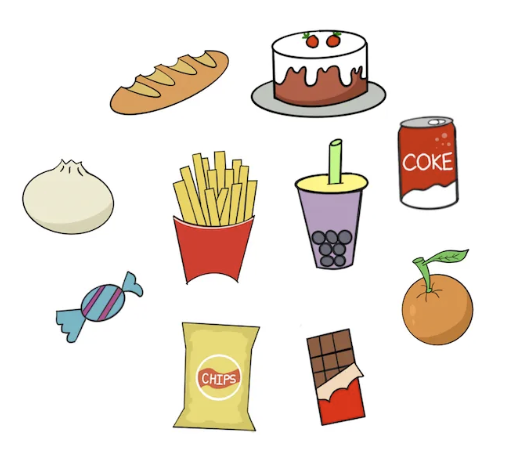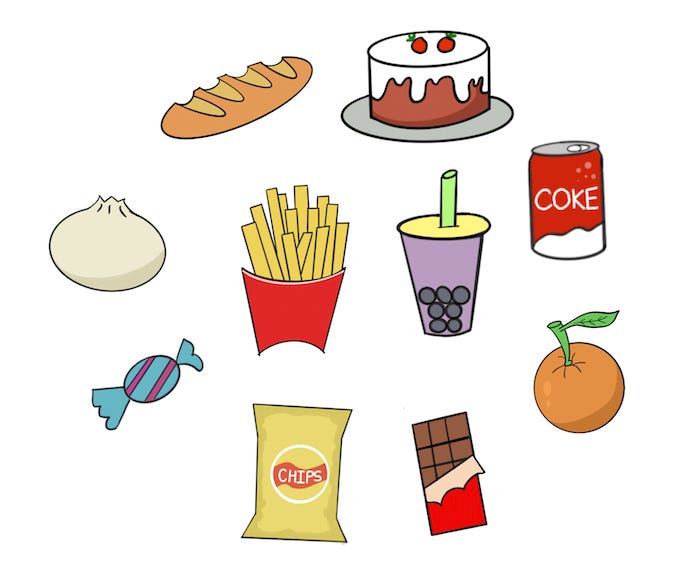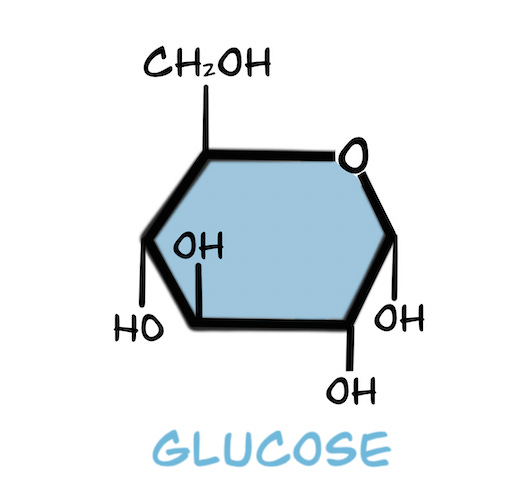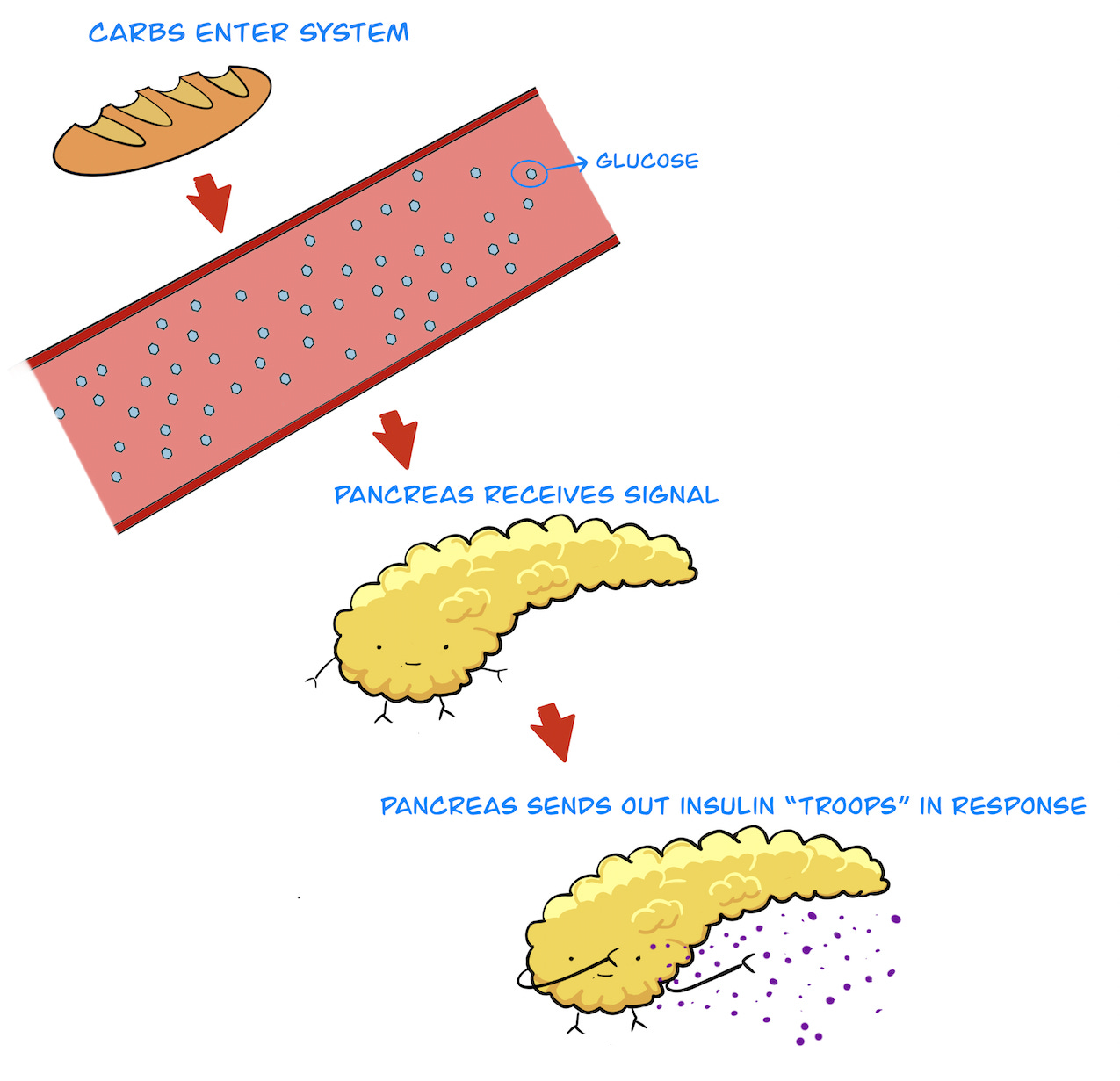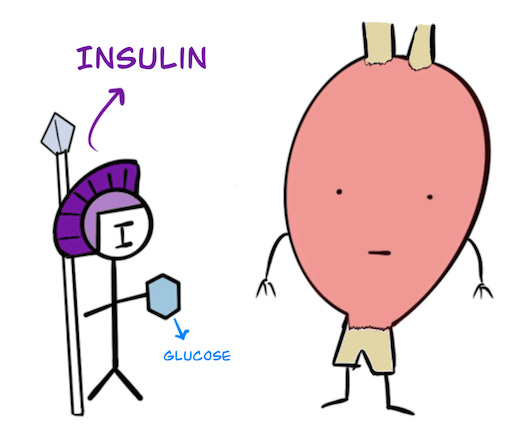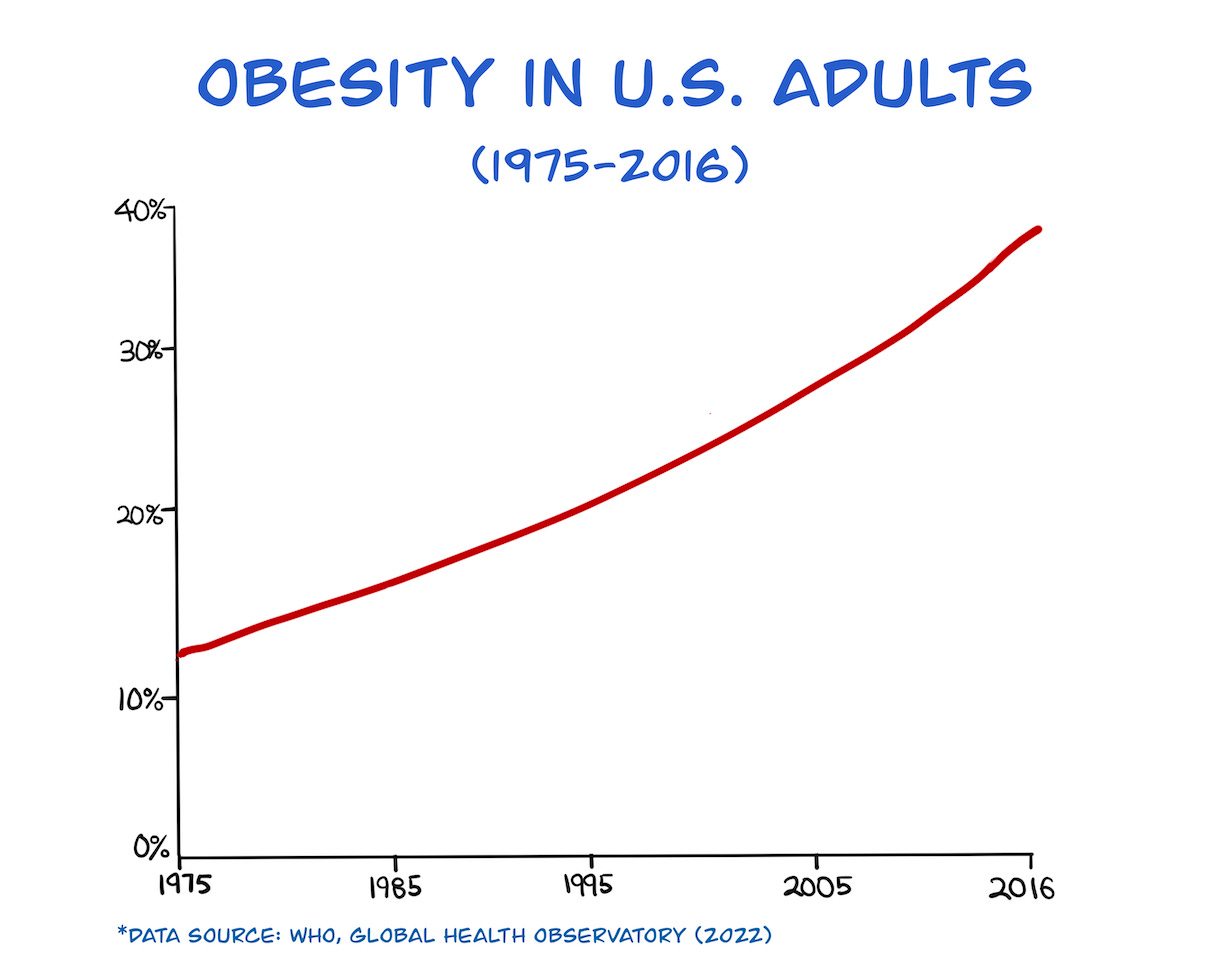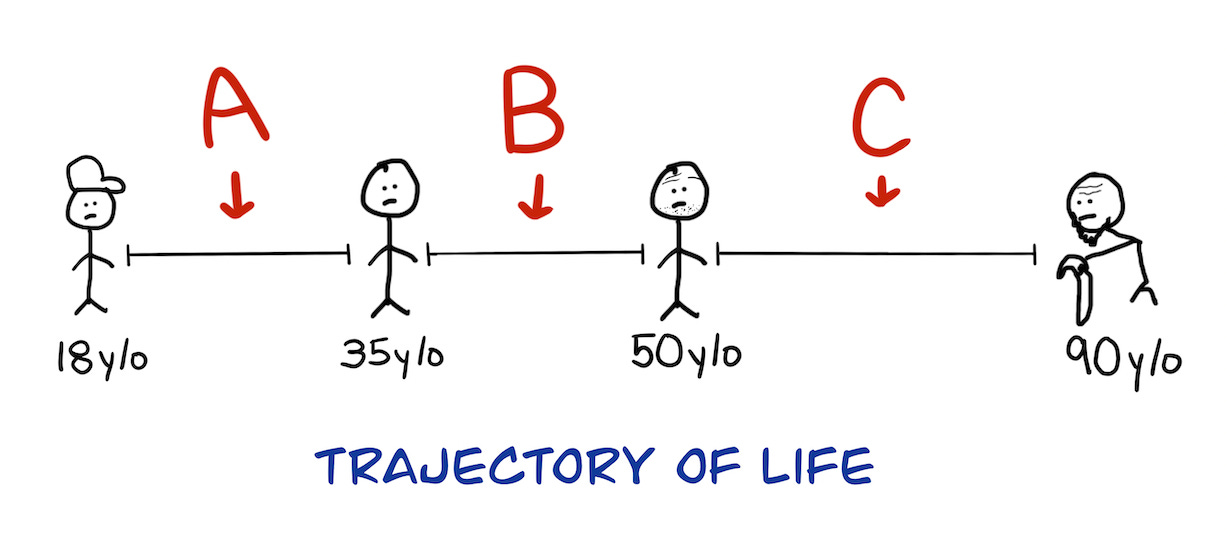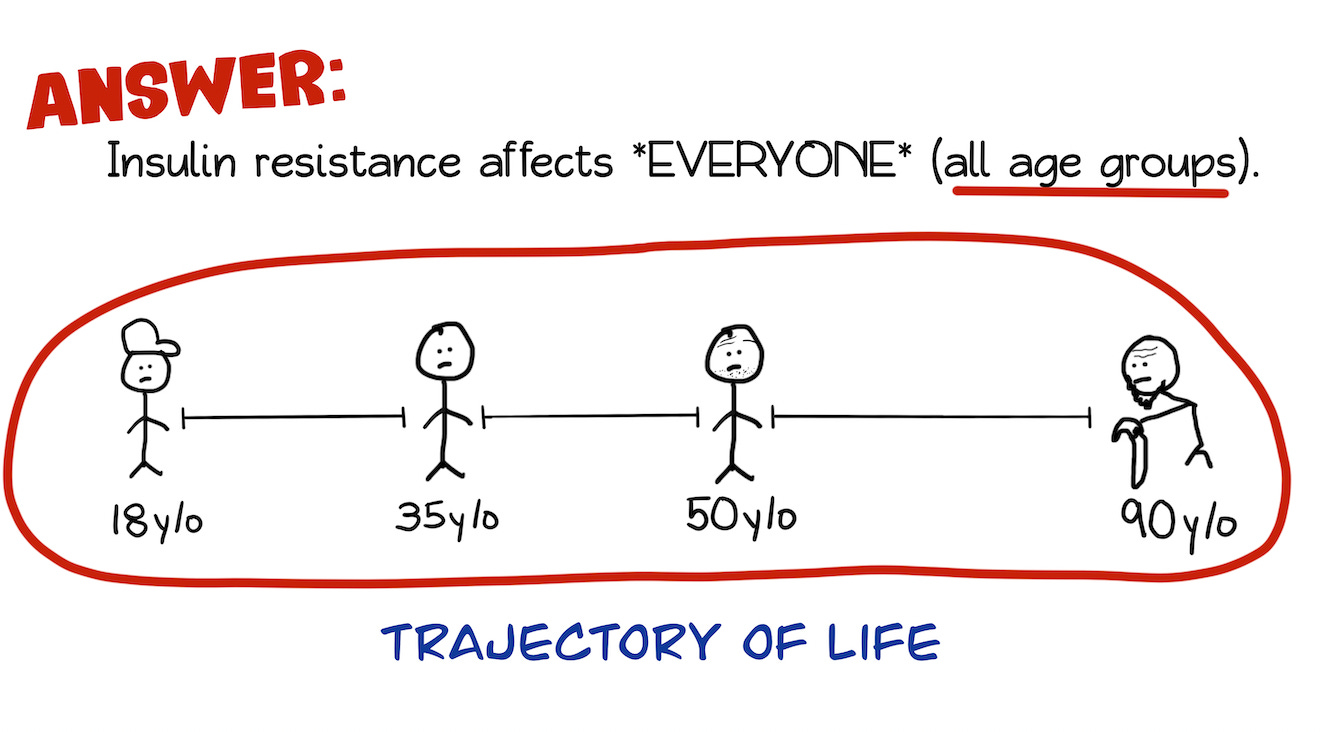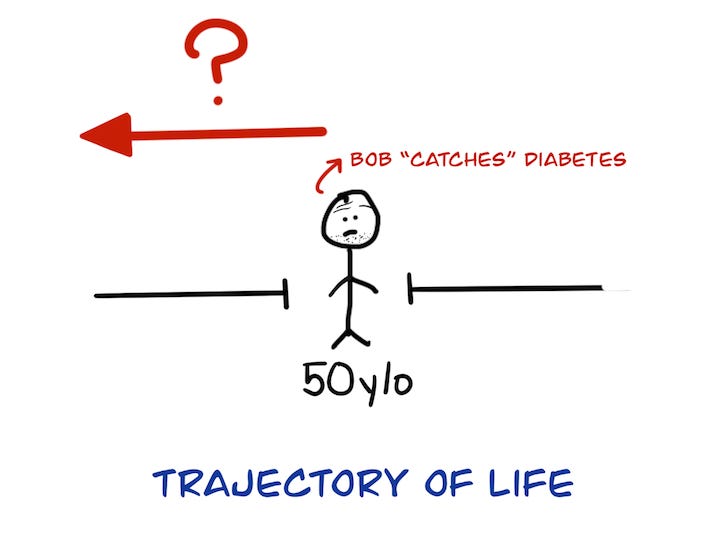Today we’ll be discussing a fundamental aspect of our health that rarely gets talked about:
Our metabolism.
In particular, we’ll be focusing on a condition called insulin resistance, which has a direct impact on our metabolism.
You may have never heard of the phrase “insulin resistance” before, and that’s okay! In fact, many people today are completely unaware of this health condition; yet it very well may be the most prevalent medical condition in the world.
Now if that’s true, that’s a pretty big deal. So let’s talk about it.
After reading this primer post, you will gain a good grasp on what insulin resistance is, what the data shows about it, and judge for yourself whether or not this is an issue worth caring about.
Without further ado, let’s dive in.
Table of Contents
- How (TF) do we metabolize carbs?
- What is Insulin?
- What is Insulin Resistance?
- Game #1 – What %?
- Game #2 – To Who?
- Game #3 – Starting When?
- Wrapping it Up / Final Remarks
How (TF) do we metabolize carbs?
Let’s first talk about what our body does with the carbs we eat.
After you take that first bite of bread, pasta, noodles, CAKE (mmm), it enters your mouth, travels to your stomach, then to your intestines. Along the way, your body ultimately digests and absorbs those carbs into its most basic form called glucose.1
Turns out, glucose is really important for us.
Specifically, it’s really important for our brain, as it uses glucose as it’s primary fuel source.2 And naturally, you need your brain to function to basically do anything. For this reason, we actually have a small amount of glucose produced by our liver flowing in our bloodstream at all times.3
Now when it comes to how much glucose the brain needs, it can usually just get by off of what the liver produces. So what ends up happening is that the majority of carbs we eat will generally just be stored for future use.4
But where?
Scientists were able to figure out that the majority of this glucose is stored in our muscles.5
In fact, you may be surprised to find out that up to 70-80% ofthe carbs (glucose) we eat ends up stored in our muscles.6
You can now thank your muscles every time you eat those tasty carbs.7
Now while it may be tempting to assume that the glucose magically ends up inside the muscle, biology tells a different story.
That’s where insulin comes in.
What is Insulin?
Insulin is a hormone that gets released into the blood by an organ called the pancreas (behind our stomach) in response to high blood glucose levels after eating.8
You can think of insulin as the hormone that broadcasts to the entire body that it’s just been fed. “Time to pack away and store the nutrients we just received ya’ll.” Fat cells will start to fatten, muscles will grow, and overall the body will be in this sort of “hunker down” mode.9

Now when it comes to glucose and our muscles, insulin is essentially what allows the glucose to enter into the muscle. In fact, without insulin’s help, the muscle is unable to absorb the glucose effectively at all. Simple as that.
And if the muscles can’t store glucose, the carbs (glucose) we eat has nowhere to go.10 This can lead to high blood glucose levels that becomes problematic.11
The key thing to remember, therefore, is that insulin is responsible for effectively controlling our blood glucose levels.12
Insulin Resistance
What is insulin resistance?
As the name suggests, it means being resistant to the effects of insulin. Simply put, the body doesn’t respond to insulin as well as it once did before.
Now you may be thinking:
“But why?” (Aka why does one become resistant to insulin?)
To this day, we still don’t know exactly why this happens.13 But one thing seems rather clear: a sedentary lifestyle, an abundance of highly processed carbs + sugar, and obesity all directly lend itself to insulin resistance.14 If you currently live in the the year 2023, then congrats – that be the type of society we live in today.
So then you’re like:
“Okay.. *eye roll* so what happens if you are resistant to insulin?”
When insulin resistance becomes pretty bad, it morphs into a disease you definitely heard of before:
Type 2 Diabetes.15
In fact, you can think of insulin resistance as the precursor before diabetes.16
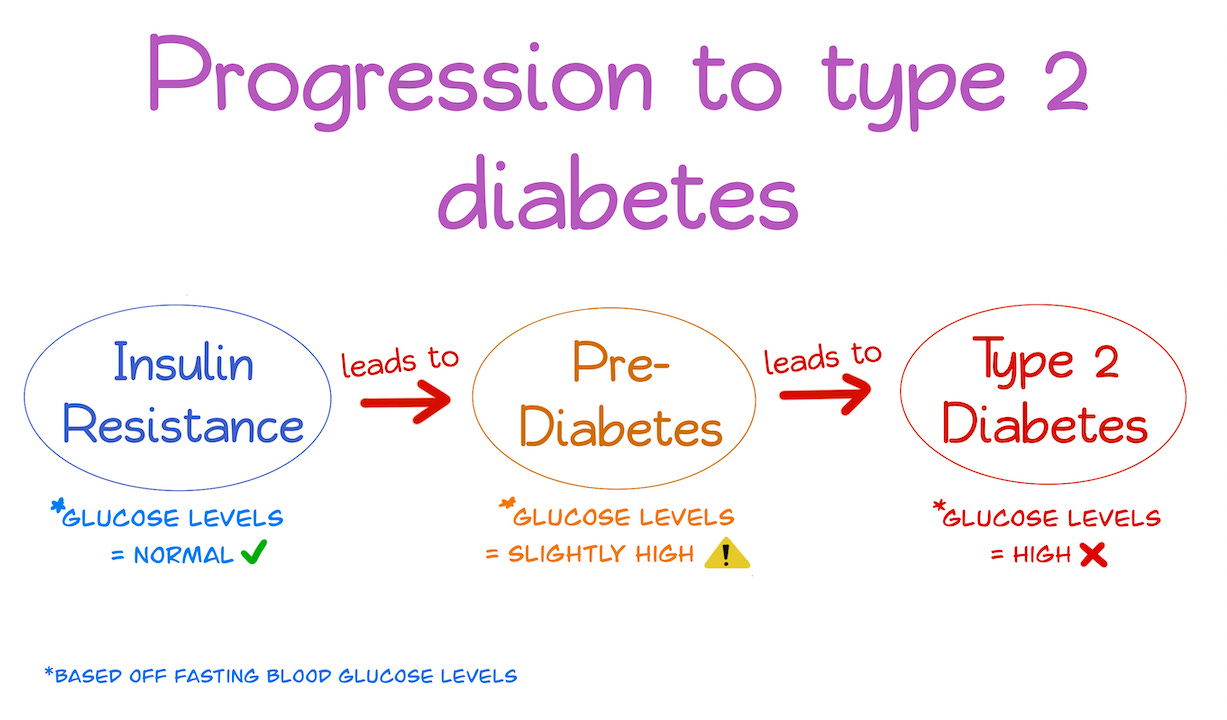
During the “insulin resistance” stage (without diabetes), glucose levels are still able to be maintained at normal levels.
That’s because the body compensates by being in a state called hyperinsulinemia – meaning it will produce a “hyper” amount of insulin to overcome the resistance it’s facing. It’s like the body is saying: “Hey, you keep resisting me and I will throw more insulin at ya.”
The problem with hyperinsulinemia is that it has its own adverse health effects, such as making it easier to gain weight (esp. fat around the organs called visceral fat), damaging our cardiovascular system, and of course, leading to type 2 diabetes if unaddressed.17
So all in all this is just to say the most important takeaway from all of this:
Insulin and its proper functioning in our body is absolutely critical in ensuring absolutely none of this happens, and in turn provides us with the best chance to live a long and fruitful life free of disease.
Game #1 – What %?
Now that we’ve gone through the basics, let’s talk about who amongst us may have this insulin resistance “thingy” anyways.
To find out, let’s play a game called
We’ll play a series of games where the goal is for you, the reader, to try to guess the number closest to the answer to the following prompts.
This is all for fun with absolutely nothing on the line (besides your pride and ego of course), so just sit back, relax, and “guess” freely.
Let’s start with the question that was just brought up:
1st Q: What percentage of U.S. American adults (18-90 years old) do you think are currently suspected to have insulin resistance?
The answer lies somewhere between 0 to 100% of all U.S. adults aged, let’s say 18 y/o – 90y/o, who are estimated to have some degree of insulin resistance. Oh, and there are about 250 million of us btw.
Think about your answer, place your bets, then scroll down.
Okay ready?
.
.
.
.
.
.
.
Was your guess close to the answer:
Explanation – the reality
I know.
This sounds way too alarmist. You may even be thinking this is another one of those widely exaggerated statistics. 88% of all U.S. adults? I mean, how could you ever believe me – a random stranger on the internet?
Believe me, I was just as shocked as you are. But to prove this, we need to look no further than something called metabolic syndrome.
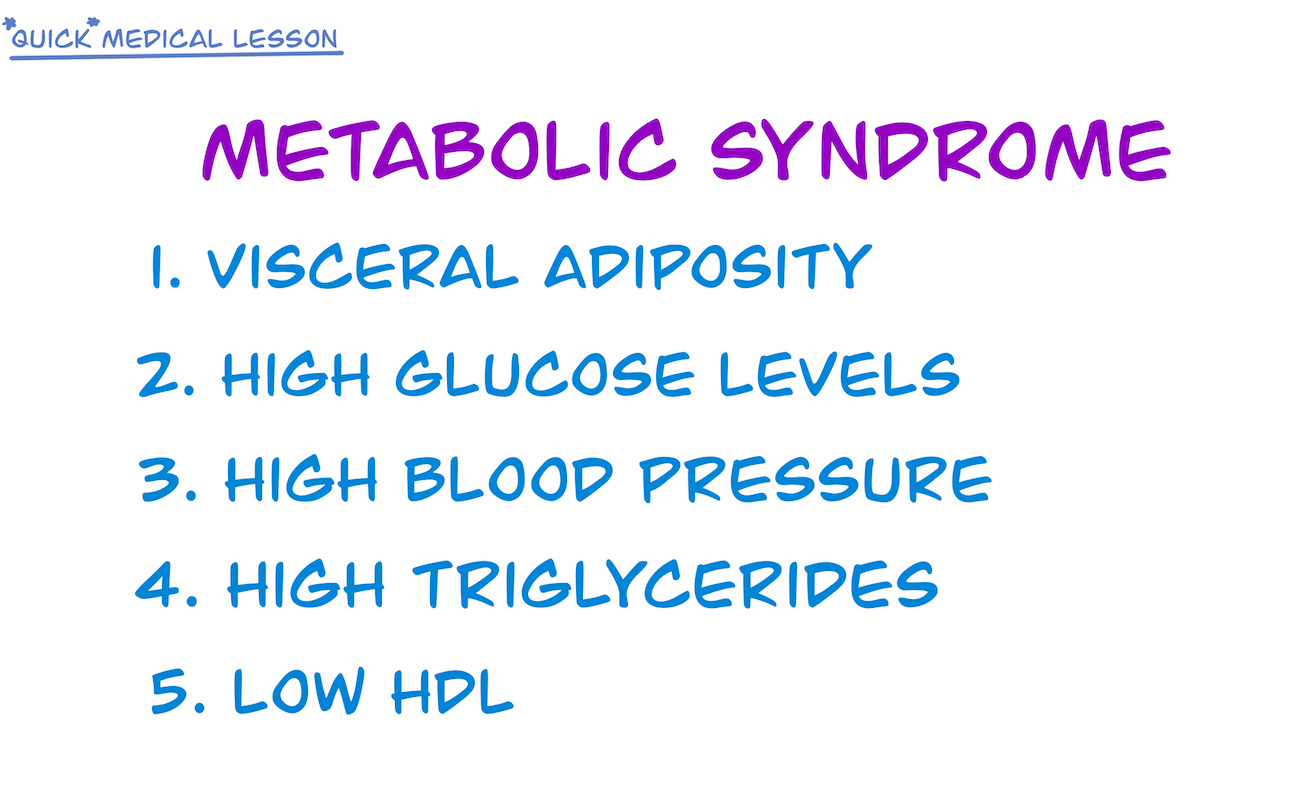
Metabolic syndrome (MetS), aka “insulin resistance syndrome,”18 consists of 5 adverse health conditions that significantly increase your risk for stuff like cardiovascular disease, cancer, and Alzheimer’s.19
Technically, you need 3 out of the 5 criteria to “qualify” for MetS, but I think we can all agree that none of the above sounds good for us.20 And the thing about MetS is that all 5 of these criteria can be directly attributed to insulin resistance itself.21
Now that’s interesting, right? Typically, when we think about high blood pressure or “bad” cholesterol, we don’t think that our metabolism may be at the root cause.
Now ask yourself: does the average American adult have at least 1 of these 5 criteria?
You betcha. In fact, there was a study done that was able to deduce that 88% of Americans possessed at least 1 of these 5 criteria, and therefore only 12% of American adults were surmised to be in true “optimal” metabolic health.22
Now granted, that 88% could be an extrapolation.
But how many people do you know (“Oh, hi,” I say to myself in the mirror) that might have some unwanted fat around their waist, a slightly high blood pressure, and / or “bad cholesterol?”23 Probably a handful of people.
In fact, we can take a look at another condition very much related to insulin resistance: obesity.
You probably already know that obesity has been on the rise; a whopping ~40% of all U.S. adults are now considered obese.
Unsurprisingly, obesity also goes hand in hand with insulin resistance (remember: hyperinsulinemia → “fat gain”). In fact, 70% of obese adults are also insulin resistant.24
But what is surprising is that obesity is not necessarily a requirement for insulin resistance either. In fact, 50% of people who are NOT obese are also insulin resistant.25
That ends up being A LOT of people.
But if we still need more convincing, let’s take a look at insulin resistance’s final form: type 2 diabetes.
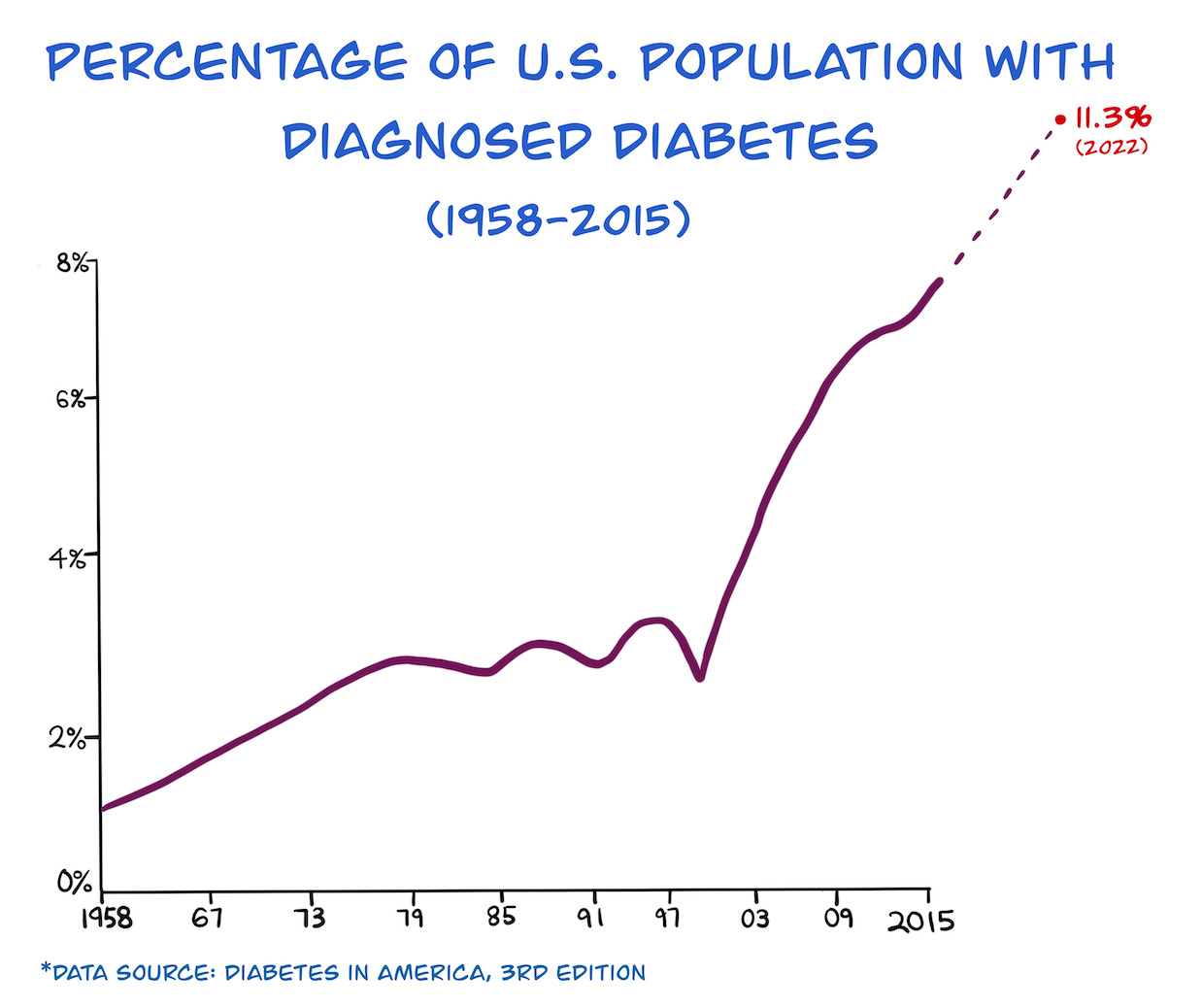
According to the CDC, there are now 422 million diabetics worldwide, which is up from 108 mil in the past. And this number is only increasing.26
As of 2022, here’s what we know: about ~11% of all Americans are diabetic, and ~50% are either diabetic or pre-diabetic.
Since insulin resistance precedes type 2 diabetes (and pre-diabetes), this then has to mean that the U.S. adults who are insulin resistant are well over 50%.
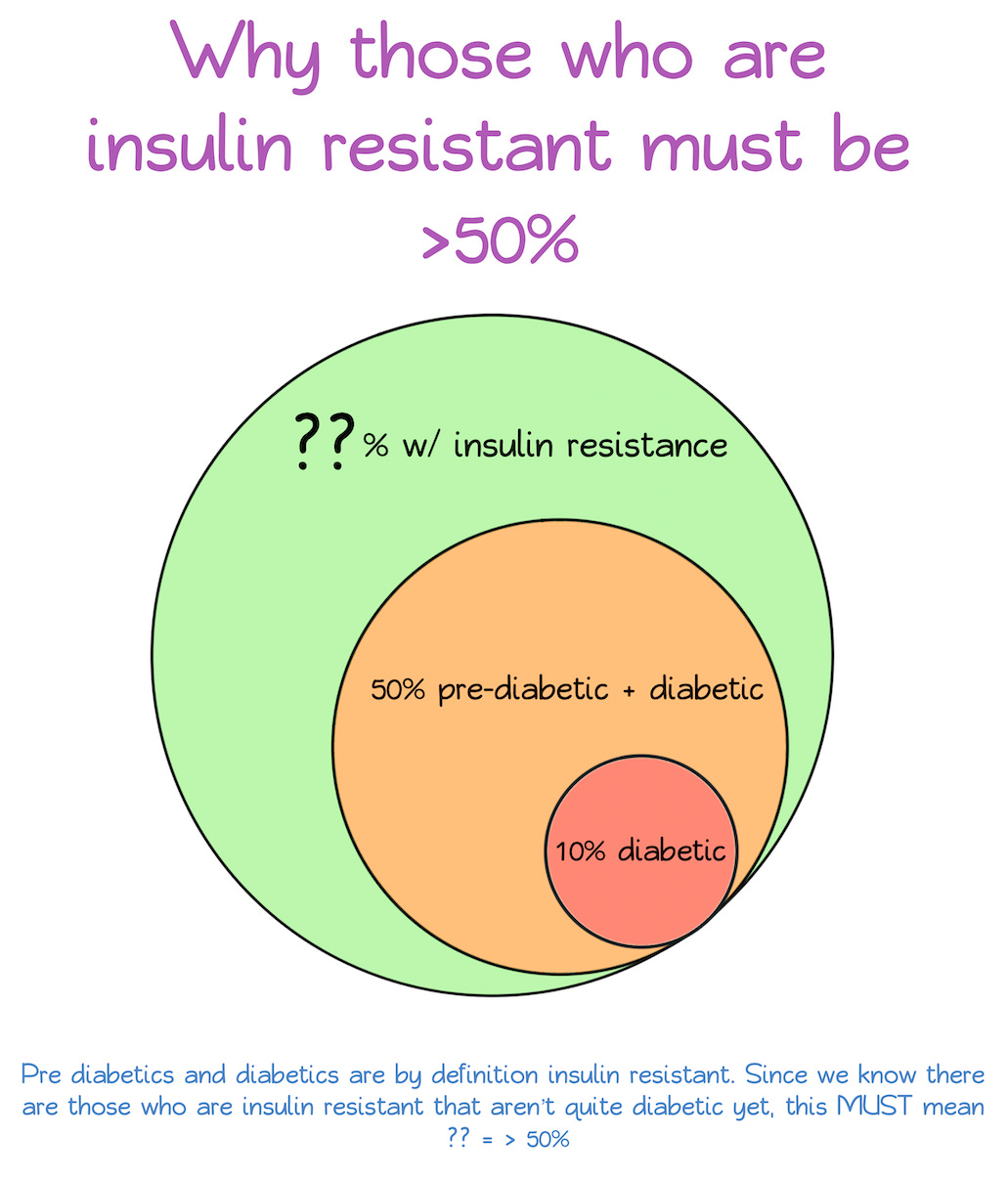
Suddenly, this 88% number doesn’t sound so unreasonable anymore.
In fact, we have a pretty compelling argument that insulin resistance is one of the most prevalent medical conditions not only in the U.S., but in the world.27
Yet not many people are aware of it.
Game #2 – To who?
“Well… thanks for all that depressing talk. Think I’m gonna go now.”
You’re welcome.
Wait, before you go though – can I offer you another round of
2nd Q: Currently, what age group is primarily affected by insulin resistance?
Let’s say this is Bob when he was 18 years old (he’s 35 y/o now).
And this is Bob when he’s 90 years old.
Which age group does insulin resistance primarily affect?
Does it affect the young? The old?
Think about your answer carefully, place your bets, then scroll down.
Okay ready?
.
.
.
.
.
.
.
Answer: How about… everyone?
Explanation – The reality
(Apologies for the trick question btw).
We’re of course inclined to think that many disease processes only occur in the elderly or at least later in life.
And that’s largely true. Many of the serious diseases like heart disease and cancer usually happens when we’re older.
But the truth is, currently, insulin resistance affects everyone.
If you’re astute, you may have already deduced this. If the majority (88%) of U.S. adults truly have some degree of insulin resistance, then this would have to mean that it affects younger adults as well – since young adults (aged 18-44 y/o) comprise about ~50% of the U.S. adult population.28
In fact, when we look at the actual numbers, here’s what we get:
- 40% of young adult Americans are affected by insulin resistance (even excluding those who are already diagnosed with diabetes).
- Half of those insulin resistant young adults were NOT obese.29
Let’s take a moment and let that really sink in.
Picture yourself at a Christmas party (it’s December right now) of about 10 people. On average, 4 out of those 10 are likely to be insulin resistant, and 2 out of those 4 are appear completely normal on the surface.
And if we were to extend all the way to the left to children and teenagers? Sorry, it doesn’t get any better.
Children and teenagers are now being diagnosed with type 2 diabetes for the first time in history.

Since insulin resistance precedes diabetes, there’s a very high likelihood that a big chunk of children in the U.S. are insulin resistant as well.30
And given what we already know about the rising trends in diabetes and obesity across the board of all ages, we know that insulin resistance affects every age group.
Quite the epidemic we got on our hands, really.
Game #3 – Starting when?
Alright dude, you’re being a total bummer so I’m outies forreal.
Yep, think we’re done here. Thanks for rea-
Before I let you go – here’s the final question:
Let’s say Bob first gets the diagnosis of type 2 diabetes when he turns 50 years old.31
Final Q: How many years (on average) before being diagnosed with type 2 diabetes did Bob first start developing insulin resistance?
In other words, how many years did it take for Bob to go from being insulin resistant to type 2 diabetes?
You know the drill – place your bets, scroll down, yadi yada, etc.
Okay, ready?
.
.
.
.
.
.
.
Was your answer close to:
Explanation – the reality
Yes, you read that correctly.
10 to 15 years.
Think about how long ago 10 to 15 years ago was from today. If I were to get diagnosed with diabetes today (like NOW), this disease process would’ve conservatively started somewhere between 2008-2013.32
Here’s another way to put it:
If you were to start developing insulin resistance today, it will take 10 to 15 years until you are finally diagnosed with type 2 diabetes to realize you’re sick, yet you would’ve likely had no idea that you carried this disease process all along, all the while perpetuating it in the process during that timeperiod (living in sweet, sweet bliss).
So what does this tell us?
That insulin resistance is this slow, insidious process that creeps up over time.
Yet our perception of what happens is closer to something like this:

I’m fairly confident that nearly all 50% who are currently pre-diabetic or diabetic were ALL completely unaware that their disease process likely started 10 to 15 years ago.33
And I know what you’re thinking.
“Nah. Don’t believe you.”
“Wait, how could “they” let this happen?”
“How come no one is diagnosing me with insulin resistance at the doctor’s?”
“Why am I only just finding out about this?”
There’s good reasons why insulin resistance is currently getting swept under the rug.
- The awareness of how important it is to address insulin resistance is still lacking in the medical community.
- There’s currently no standardized way of measuring insulin resistance, nor is there any consensus on how insulin resistance should be graded / assessed in the clinical setting.34
- The modern healthcare system is really designed to treat you when you’re really sick (ex. type 2 diabetes), but not good at preventing it from happening in the first place (ex. insulin resistance).
- You’re just quite not “sick” enough to warrant the attention of healthcare professionals with just being insulin resistant.
- Insulin resistance is mainly asymptomatic.
That last point of it being asymptomatic is absolutely critical, and is probably the main reason why insulin resistance often gets missed.
The problem with insulin resistance is that you won’t have any blatant symptoms that ail or plague you. What ends up happening is that we go through life thinking we’re okay. Then, we end up paying the price later rather than today. And along the way, we suffer the consequences of insulin resistance. All the while believing that we’re in good health.
In essence, it’s like being infected with a virus that slowly erodes away at us.
And since none of us are currently being diagnosed with insulin resistance, there are even more of us out there who are completely unaware that we may have this adverse health condition.
Dare I say, it’s not that much of an exaggeration to say that insulin resistance is the “silent killer” of modern day.
Wrapping it up
Okay, so that was a lot. Here’s what YSK based on everything we just talked about:
How pervasive insulin resistance is in our current population (up to 88%),
How it affects all age groups (even young adults, and now children)
How early it starts before the diagnosis of diabetes or even pre-diabetes (10-15 years).
We’ll wrap things up by briefly touching upon the two main questions as it pertains to us:
1) How do I know if I have insulin resistance?
If one or more of the following apply to you, insulin resistance may be at the cause:
- Difficult to lose weight, despite true efforts.
- Unwanted fat around the belly.
- High blood pressure.
- “Bad cholesterol” (high triglycerides, low HDL, high LDL)
- Unexplained acne, skin tags, or dark patches of skin
- Polycystic ovarian syndrome (PCOS)
- Erectile Dysfunction (ED)
2) What do I do about it?
The thing about insulin resistance that is most reassuring is that it is most effectively addressed through lifestyle changes (and all of these will be expounded upon in future blogposts):
- Exercising on a regular basis (especially both aerobic (ex. Zone 2) and anaerobic (ex. resistance training, Zone 5)).
- Eating well (avoiding certain foods such as refined carbs and sugar).
- Sleeping well (very important for glucose control, actually).
- Decrease adiposity, and especially visceral fat.
Final Remarks
The older we age, the more damages we accrue naturally along the way.
And the same applies with insulin resistance. Just like how our metabolism slows down, it is true that our sensitivity to insulin will also naturally go down over time.35
The goal isn’t to completely eradicate insulin resistance, nor to stop the process of aging.
But what we can do is slow the process down through our awareness and effort.
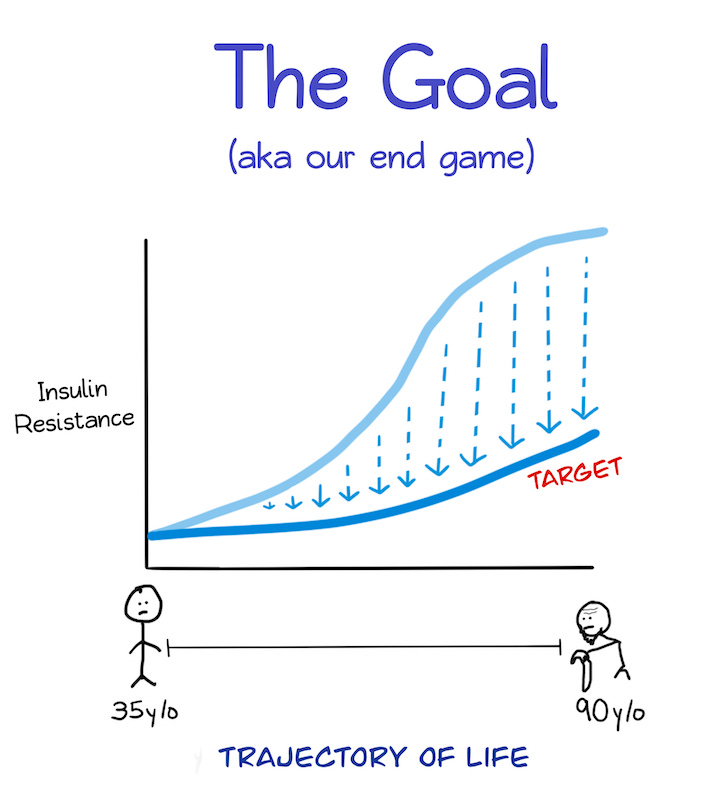
So we’ll start with our awareness regarding the issue. Then, we can talk about what we can do about it in detail.
And we’ll do just that in our next post.
Thanks for reading.
*Disclaimer: Nothing discussed in this post constitutes as medical advice. Always consult your doctor, etc.
*As a reminder, please fact-check anything that has been said in this post (and in general, whatever you read on the internet in general. If you read this far, then congrats! You now have a good grasp now on what we are dealing with. I am glad you had the opportunity to be aware of this health condition.

